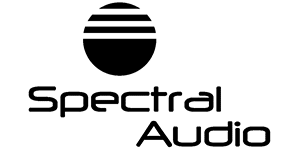
Spectral Audio which is based in Switzerland was founded in 1995. The brand specializes in the production of hardware synthesizers sporting MIDI impementation.
The first example of the company's development was ProTone analog synthesizer which is still in demand among those who work in modern music MIDI studios. This is a monophonic synthesizer operating on two analog oscillators. Each VCO generates sawtooth and pulse waveforms. There’s also a white noise generator and a ring modulator. In addition to the oscillators, ProTone included a powerful resonant filter, an LFO with six types of sound waves + noise and a “random” function (as well as a wide range from 0.005 to 3800 Hz), MIDI functions and CV/Gate control. The instrument differed favourably from other products thanks to fairly simple control featuring convenient knobs and switches on its front panel. The interface made the adjustment of the instrument simple and intuitive which, of course, was highly appreciated by any newcomer to the world of sound synthesis. Like Roland TB 303, the ProTone also had the Accent function which is all about Decay envelope for the 12/24 dB filter while the standard ADSR is provided for the amplifier. Despite its capabilities ProTone didn’t have program memory but it was able to produce fatty, saturated analog basses and high-quality synth sounds. ProTone synthesizer was discontinued in 1998, but Protone has seen great times when it used to be considered an excellent affordable and reliable alternative to many other vintage analog monosynths with two VCOs.
Following the success of ProTone mono synthesizer Syntrack came out - a monophonic synth combining a digital wavetable synthesis and an analog cascade filter. The output of the filter is processed by an analog distortion stage owing to which the sound becomes fearsome and severe. Syntrack is a 1U rack module with full MIDI implementation and aggressive analog sound. The synthesizer also had a memory for 99 user programs (29 of which were standard presets) and each parameter was easily manageable. The wavetable oscillator could be elaborated by an additional chip doubling the memory. An external audio source can be passed through the filter module via audio input. The new synthesizer provided the musicians with a truly unique and powerful sound in a very affordable manner.
Neptune analog instruments equipped with MIDI capabilities came out in 1999. The architecture is similar to the well-known ProTone but the sound of the instrument was sculpted in a completely new way due to his own new resonant filter. The instrument included three analog oscillators along with a cascade 24 dB filter to create that familiar fat sound inherent in Moog. The instrument included the basic specification of its predecessor ProTone with the only difference that Neptune could have a third VCO (since the LFO was capable of switching to oscillator mode) and could also assign the ADSR to the filter. Like ProTone, Neptune offers MIDI in/out, CV + Gate in/out, and MIDI/CV/Gate conversion which makes it a good model for both old school and modern MIDI studios. Neptune features MIDI controllable cutoff frequency and modulation.
The next improved model of Neptune - Neptune MkII synthesizer - entered the music market in 2003. The instrument included an enhanced white noise generator, a volume control, a new pulse-width modulation possibility exerted on the square waveform of any of the oscillators, faster envelopes, synchronization of the third oscillator with the first or second one, and an increased tuning range for all the oscillators. Neptune is a completely analog synthesizer which, however, means no memory for patches. Twisting the knobs of this machine is a pleasure - as a result you ge interesting, unusual airy and resonant noises.
Cyclus 3 analog MIDI sequencer appeared in 2007. This device had no problems with internal memory: 112 sound patterns and 30 songs (each with 80 possible rhythm pattern steps and up to 32 possible loops) are instantly here to use them. Cyclus 3 sequencer has included 8 tracks and each track has 5 sub-tracks: note (pitch), xtranote, step length, note off time function, velocity, ctrl value, ctrl length, ctrl glide. All tracks can be played independently; one track can modulate the other one. The instrument allows you to quickly change the settings in real time and has the ability to automatically analyze the tracks and rework them in accordance with the style, create tracks step by step. Sound data can also be imported from other sequencers. Thanks to the MIDI support Cyclus allows you to update the software expanding its capabilities. Cyclus 3 combines an analog and digital sequencing style which increases its accuracy. The instrument can also be used as a module combined with other sound synthesis products featuring MIDI implementation.
Spectral Audio is represented with high-end audio electronic products which have been produced for more than two decades and keeps the brand afloat. Today the company continues to pave its way through the jungles of the market and establish its High-End standards. The result of the careful quality assembly is in production of high-level instruments highly appraised by professionals.


